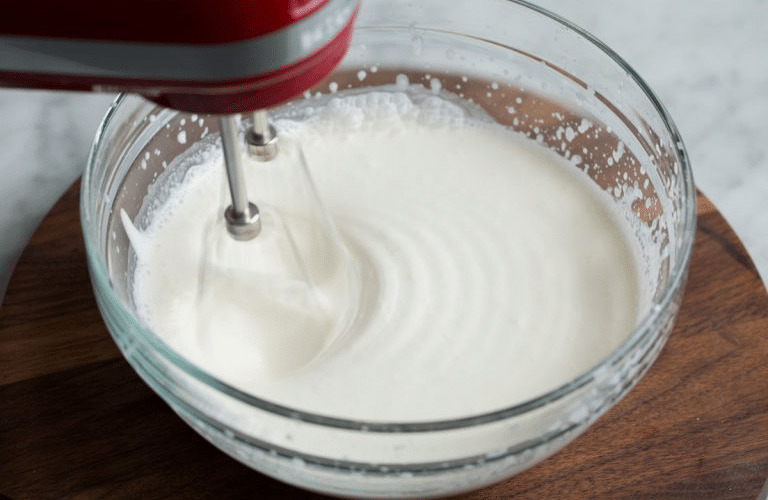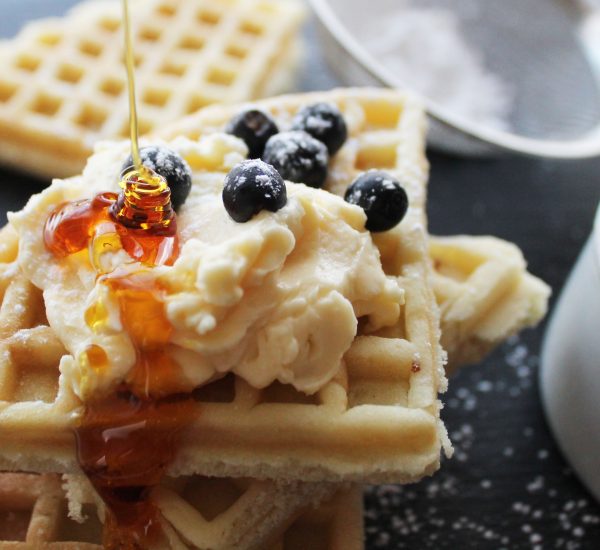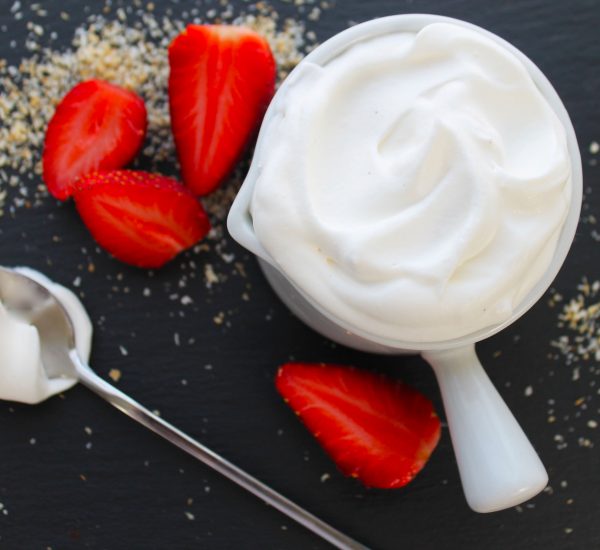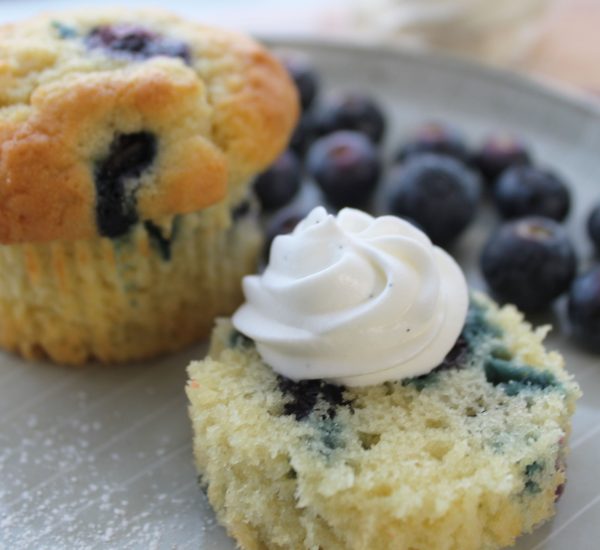Is there a finer accompaniment to a dessert than whipped cream? Whether it’s a bowl of freshly-picked strawberries or a decadently delicious chocolate brownie, whipped cream is as flexible as it is flavourful. There’s just one problem – many people often find their whipped cream won’t whip as it should, leaving them without the finishing touch to their dinner party dessert.
There are plenty of reasons this happens and fortunately, all of them are easy to remedy. We’ve compiled them all into a handy list for you below, comprising a one-stop shop for the next time you’re having trouble achieving those light and airy peaks that make whipped cream so irresistible. Kiss your whipped cream woes goodbye!
1.) You’re not chilling your cream
Using room temperature cream is the cardinal sin of whipped creamery and the number one reason for whipped cream not thickening. If it reaches above 10°C, the fat inside the cream will not emulsify, meaning it can’t hold the air particles which allow it to maintain fluffy peaks.
- Refrigerate your cream for at least a couple of hours before whipping
- Do not leave sitting at room temperature for any length of time
- Whip immediately!
2.) You’re not chilling your bowl
A crucial step that is often overlooked, chilling your bowl is just as important as chilling your cream. Once the chilled cream comes into contact with a warm or even room temperature bowl, the fat inside it will immediately begin to lose its emulsifying properties. In fact, you should even chill the utensil you plan to whip the cream with to make doubly sure!
- Refrigerate the bowl along with the cream for at least an hour
- For even better results, refrigerate the whisk or other whipping utensil as well
- Again, don’t waste any time once all of the above have been removed from the fridge
3.) You’re using cream that makes it too thick
Many people like to keep a stock of all-purpose cream on hand, which is a great versatile addition to all manner of sweet and savoury dishes. However, it’s not the ideal choice for when it comes to whipping, since it’s too dense to create the airy texture needed for floaty mounds or stiff peaks. Instead, you should aim for heavy cream or the aptly-named whipping cream.
- Avoid all-purpose cream or any other cream that is of equal or greater thickness
- Try to use heavy cream or whipping cream when possible
4.) You’re using cream that makes it too thin
As mentioned above, heavy cream or whipping cream are the perfect consistency for whipping. Any others, including single cream, half-and-half or just plain old milk will not serve your purpose and, no matter how much elbow grease you put into the whipping, will not achieve the fluffiness needed. As a benchmark, look for cream with at least 30% fat.
- Make sure you use the appropriate cream with at least 30% fat
- Steer clear of thinner alternatives
5.) You’re using thawed frozen cream
This is a bone of contention on the internet, since some observers seem to be of the opinion that frozen cream can be thawed and successfully whipped, although the process may involve adding an agent to help re-emulsify the cream. For those unsure, it’s best to simply use fresh cream every time. After all, you can always freeze the cream after it’s whipped rather than before.
- Only use fresh cream for whipping unless you cannot avoid it
- If you are using frozen cream that has been thawed, add an emulsifying agent such as soy lecithin
6.) You’re using old cream
Using produce that has gone past its expiry date is not recommended at the best of times, but when it comes to dairy, it’s a massive no-no. Even cream which is still in date but has been sitting in your fridge for a couple of days is not ideal. For the best results, use fresh cream bought that day as it will be far easier to manipulate and can even show great results in less than a minute.
- When possible, buy cream on the same day you intend to whip it
- Avoid using cream that has been kept in the fridge for two or more days
- Never use out-of-date cream for whipping or any other purpose
7.) You’re using organic cream
Organic produce offers a number of consumer benefits, including sustainability and ethical purchasing. However, organic cream isn’t the perfect choice when it comes to whipping. That’s not to say there aren’t organic options which will whip, just that the same stiff peaks are unlikely to be achieved with an organic alternative as with the standard version.
- Where possible, use fresh or UHT standard cream for whipping
- If buying organic is a red line, make sure the label states that it is suitable for whipping
8.) You’re using the wrong bowl
Just as it’s important to use the right kind of cream, it’s also important to use the right kind of bowl when it comes to whipping. The preferred options are bowls made out of either glass or metal, since they will not offer any chemical reaction when interacting with the cream that could upset the process. Plastic bowls are manageable but trickier, while copper bowls should be avoided altogether.
- Use a glass or metal bowl to whip your cream if possible
- Use plastic only if there is no alternative available
- Never use a copper bowl when whipping cream
9.) You’re using the wrong whipping utensil
That also goes for the tools you use to do the actual whipping. A wooden spoon is a great kitchen utensil, but it doesn’t have the porousness or the deftness to give good results when whipping. A purpose-designed whisk is the best option, either of the handheld balloon variety or an electric mixer with a whisk attachment. This will allow plenty of air bubbles to infiltrate the cream.
- Use a handheld balloon whisk or an automatic electric mixer with a whisk attachment
- Do not use a wooden spoon or any other blunt implement when whipping
10.) You’re whipping too much
Just like cooking pasta or boiling an egg, there is a tipping point when it comes to whipping cream. If you do end up overwhipping, your cream will begin to deflate and take on a grainy texture. This is not what you want.
To ensure this doesn’t happen, it’s best to test your cream every minute or two. You can do this by swirling it round loosely with a spoon or other implement (even the whisk itself will do, as long as you aren’t vigorously whisking). If the cream holds the shape for a few seconds before gradually collapsing, it has attained “soft peaks”; if the shape is held more firmly, you’ve arrived at “firm” or “stiff peaks”. Either of these is fine and so is anything in between. Depending on your preference, you should decide when to stop whipping.
If you discover that you’ve gone too far and the cream has been overwhipped, don’t worry. It’s perfectly possible to still salvage the mixture by simply adding a tablespoon of fresh cream at a time and whipping until it has returned to either the “soft” or “firm” status.
- Test your cream every minute or so to see if it has reached optimal consistency
- Anywhere between “soft peaks” (where it holds its shape for a few moments before gently falling down) and “firm peaks” (where it holds its shape more rigidly) is ideal
- If you do overdo it, simply add a tablespoon of fresh cream at a time until the right consistency has been achieved
11.) You’re adding too much or too little sweetener
A surplus or lack of sweetener shouldn’t actually affect the structural integrity or whipping capacity of your cream – but it will make a massive difference to its taste and can potentially make or break a dish.
Bearing in mind that whipped cream is almost always used to accompany desserts that already have a sweet taste, you might want to proceed with caution when it comes to adding sugar or an artificial sweetener. At the same time, using completely unsweetened whipped cream can result in a bland and unsatisfying end product.
For beginners, a good starting point is to use one tablespoon of sugar or sweetener per cup of cream you use. Working from there, you can further sweeten the cream if necessary, depending on the dessert involved and your own personal preference.
- Be wary of over-sweetening cream that is intended to accompany dishes which already contain a fair amount of sugar
- Remember that unsweetened whipped cream is just as bad
- Add one tablespoon of sugar or other sweetener per cup of cream as a starting point
- Work out your own personal preferences based on the situation and adjust accordingly
12.) You’re adding your sweetener at the wrong time
While the amount of sweetener you use won’t affect your whipped cream consistency too much, the point at which you add it can make a world of difference. One rookie mistake is to pour in sugar or artificial sweetener at the beginning of the process before any whipping has taken place – this is a sure-fire recipe for disaster.
Instead, the sweetening agent should be folded in after “soft peaks” have been achieved but before they have been converted into “firm peaks”. Making sure you time your sweetener right is crucial to achieving the ideal consistency and flavour for your whipped cream.
- Do not add sugar or any other sweetener at the beginning of the whipping process
- Wait until the cream has achieved “soft peak” consistency
- Add the desired amount of sweetener before the “firm peak” stage has been reached (i.e. before the whipping process is complete to achieve good distribution)
13.) You’re using the cream too quickly
If you’ve gone through the whole rigmarole of all the steps outlined above and achieved the perfect peaks and a delicious tasting whipped cream, the last thing you want to do is see it melt on contact with its accompanying treat. Whether it’s a slice of cake fresh from the oven or a waffle out of the grill, piping hot desserts are guaranteed to turn your beautiful creation into a sodden mess.
For the most aesthetically pleasing results, wait until the dessert has cooled to an acceptable level before embellishing it with your peaky goodness.
- Avoid placing freshly whipped cream onto piping hot desserts as they will only melt it
- Wait until the dessert has cooled to an acceptable level before using your cream
14.) You’re not using the cream quickly enough
The previous rule is an important one, but it’s equally essential to note that ambient room temperatures – especially on a hot summer’s afternoon, when whipped cream is often at peak (excuse the pun) demand – are not your friends. If you leave your whipped cream out of the fridge for too long after you’ve made it (while waiting for your dessert to cool or for whatever other reason), it will soon wilt under the heat.
The good news is that whipped cream can safely and easily be refrigerated for an hour or two before use. Any longer than that and you run the risk that it may begin to separate. If you really must refrigerate for longer, place it in a fine-mesh strainer on top of a bowl, allowing any excess liquid to drain away. You can also freeze it for up to three months with surprisingly good results.
- Never leave whipped cream out of the fridge for an extended period of time
- You can safely refrigerate it for a couple of hours without affecting its taste or form
- If you must refrigerate it for longer, place it in a fine-mesh strainer over a bowl
- If you want to make a batch of whipped cream, you can freeze it for up to three months
15.) You’re rushing the whole process
Once you’ve got the knack of it, whipping cream should not be a difficult or time-consuming process; in fact, practiced cream whippers can achieve perfect results in less than a minute if all the ingredients and equipment are ready to go!
Having said that, this doesn’t mean that speedy results are a prerequisite or that taking your time means you’re doing it wrong. Indeed, if you rush the process, you’re more likely to fall foul of the one of the common errors listed above and end up with a disappointing end product. The best whipped cream is always the one created with care and attention.
With that in mind, you should make sure you have enough time to assemble all the ingredients, chill everything that needs chilled and whip the cream the way it should be whipped. If you know you’ll have little leeway directly before serving the cream, you can make it several hours or even days in advance by using the refrigeration and freezing methods outlined above.
- Invest time, care and attention in your whipped cream
- Follow all the steps mentioned above, giving plenty of time for each, and you can’t fail to succeed
- If necessary, whip the cream beforehand and refrigerate or freeze until needed
If you are still having trouble, we would recommend buying some cream chargers so the cream can be whipped instantly. Especially in a commercial environment!




